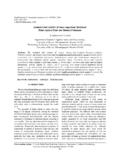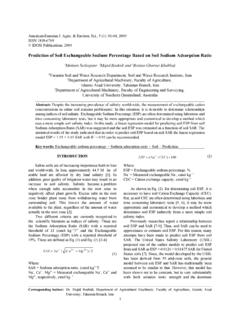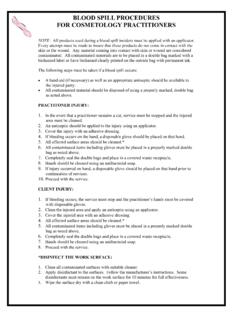Transcription of The Disinfectant Effects of Benzalkonium Chloride …
1 American-Eurasian J. Agric. & Environ. Sci., 12 (1): 23-29, 2012 ISSN 1818-6769 IDOSI Publications, 2012 Corresponding Author:Ali Fazlara, Department of Food Hygiene, Faculty of Veterinary Medicine,Shahid Chamran University of Ahvaz, Iran. Tel: +989123091813,Fax: + Disinfectant Effects of Benzalkonium Chlorideon Some Important Foodborne PathogensAli Fazlara and Maryam Ekhtelat12 Department of Food Hygiene, Faculty of Veterinary Medicine,1 Shahid Chamran University of Ahvaz, IranDepartment of Microbiology, Faculty of Veterinary Medicine,2 Shahid Chamran University of Ahvaz, IranAbstract: Antimicrobial chemicals are widely applied in the food processing industry. In attention to extentuses of disinfectants, it is necessary to evaluate and certificate the efficacy of disinfectants and employing theminimum effective dosages. In this research the antibacterial influences of a common Disinfectant solution usedin food industry, Benzalkonium Chloride that is a quaternary ammonium compound, were evaluated on siximportant foodborne pathogens including three Gram positive (Staphylococcus aureus, Listeriamonocytogenesand Bacillus cereus) and three Gram negative bacteria (Salmonella typhimurium, Escherichiacoliand Pseudomonas aeruginosa).
2 According to the obtained results after three times conducing experiments,Listeria monocytogenes and Bacillus cereus were the most sensitive and resistant studied bacteria with MICand MBC equal to 30 & 35 mg/L and 140 & 160 mg/L respectively. In attention to obtained results, the useddisinfectant has good antibacterial Effects . Benzalkonium Chloride was more effective on Gram positive thanGram negative bacteria, except Bacillus cereus because of its ability to spore formation. In attention to extentresistance towards quaternary ammonium compounds, further studies have to be done to verify if the bacteriadevelop resistance toward common disinfectants such as the Benzalkonium words: Disinfectant Benzalkonium Chloride Bacteria Foodborne PathogensINTRODUCTIONIn the food industry, regular cleaning andFood provides an excellent environment forcontrolling levels of pathogenic microorganisms that aremicroorganismsto grow [1].
3 Adhesions ofprevalent in food and the environment and have themicroorganisms to equipment surface have the potentialpotential to cause serious illnesses [10, 11]. The cleaningto transmit pathogens to food and this is apparent in theprocedures involve the use of detergents, which are notfood processing industry [2-4] and in the domesticdesigned as antimicrobial agents but to break down foodenvironment [5]. Therefore surfaces of equipment used forsoils and remove surface contamination, followed byfood handling and processing are recognized as sourcesapplications of disinfectants that reduce the viability ofofmicrobial contamination and remaining organisms [11].Recontamination is the primary source of bacterialThere are many kinds of disinfectants for foodpathogens in many commercially prepared ready to eatutensils, such as alcoholic solutions and hypochloricfood [6].
4 The number of foodborne illness outbreakssolutions including sodium hypochlorite, peracetic acid,linked to the presence of pathogenic microorganismsalcohol based products and quaternary ammoniumon fresh produce has increased over the past (QACs) such as Benzalkonium chloridePossible contamination sources are soil, feces, manure,(BAC), a synthetic antimicrobial agent with a broadirrigation and washing water, animals (including insectsspectrum antimicrobial [11-13]. The QACs are amphotericand birds), product handling, harvesting and processingsurfactants generally contain one quaternary nitrogenequipment and transport [7-9].associated with at least one major hydrophobicdisinfection procedures are the most effective way ofAm-Euras.
5 J. Agric. & Environ. Sci., 12 (1): 23-29, 201224substitute [14]. QACs are cationic biocides that aresanitizer is the most popular rinse free hand sanitizercommonly used as disinfectants in food productionformula for normal hand washing [23]. Also intranasalenvironments [15]. BAC is a QAC that is widely used asproducts containing the preservative BAC appear to bedisinfectant and cationic surface active agent forsafe and well tolerated for both long term and short termsanitation in food processing lines and surfaces in theclinical use [24].food industry [4], as clinical Disinfectant and antisepticCationic antimicrobials including the QACs have(topical) in health care facilities and domestic householdsbeen in general use within clinical and domestic settingsand as antimicrobial preservative in drugs in lowfor over half a century.
6 Recently, the use of antisepticsconcentration [16, 17]. BAC is the product of aand disinfectants has been questioned in such settingsnucleophilic substitution reaction of alkyldimethylaminebecause of the possibility that chronic exposure of thewith benzyl Chloride [17].environment to such agents might select for lessQACs are active against bacteria and some viruses,susceptible strains towards these agents [14, 25, 26].fungi, yeasts and protozoa. The solutions areResistance to disinfectants based on QAC is a potentialbacteriostatic or bactericidal according to theirproblem in the food processing industry [27]. Concernsconcentration [1]. They may provide effective treatmentabout bacterial resistance have led to calls for increasedin bacterial removal without affecting the structuraleducation of both public and professionals on theintegrity of produce [18].
7 BAC acts on general membranecorrect use of disinfectants and antibiotics. Additionally,permeability, causing the cytolytic leakage of cytoplasmicmore stringent infection control measures have beenmaterials at low concentrations with damage to the outeradvocated in order to reduce the transmission of infectionmembrane and promote their own intracellular uptake and[14, 28, 29].entry. At high concentrations, they target the carboxylicIn the present study a conventional antiseptic agent,groups and cause general coagulation in the bacterialBAC was applied against some food pathogeniccytoplasm [19, 20]. Their surfactant ability and positivemicroorganisms and the bacterial effectiveness of it wascharge provide a great capacity to penetrate and adhereevaluated against some important foodborne Gramto porous surfaces [14, 21].
8 The outermost surface ofpositive (Staphylococcus aureus, Listeriabacterial cells universally carries a net negative charge,monocytogenesand Bacillus cereus) as well as Gramoften stabilized by the presence of divalent (Salmonella typhimurium, Escherichia coliandThis is associated with the teichoic acid andPseudomonas aeruginosa) elements of Gram positive bacteria, thelipopolysaccharide of Gram negative bacteria and theMATERIALS AND METHODS cytoplasmic membrane itself. It is not therefore surprisingthat many antimicrobial agents are cationic and have aMaterials, Bacterial Strains and Culture Conditions:high binding affinity for bacterial cells. Often, cationicTen percent commercial BAC was purchased from theantimicrobials require only a strong positive aureus(ATCC 6538), Listeriatogether with a hydrophobic region in order to interactmonocytogenes (ATCC 19118) and Bacillus cereuswith the cell surface and integrate into the cytoplasmic(ATCC 11778) as Gram positive andSalmonellamembrane [14].
9 Typhimurium (ATCC 14028), Escherichia coliTo assess the suitability of an antiseptic agent, both(ATCC 25922) and Pseudomonas aeruginosathe microbicidal activity and the cytotoxic effect must be(ATCC 25619) as Gram negative bacteria were into consideration to select biocompatibleFor the antimicrobial activity measurement, first of allantibacterial agents [22]. BAC based disinfectants areactive cultures were generated by inoculating a singlenontoxic, non tainting and odor free at use dilutions andcolony of each bacterium into 5 ml sterile nutrient brothcompatible with nonionic, ampholytic and cationic surface(Merck) and incubating at 37 C for 24 h. Freshlyactive agents. BAC is widely used in the formulation ofsynchronized cultures of bacterial strains forming initialcleaner and sanitizers for dairy industry, food storageinoculums were prepared after two times overnighttanks, catering industry and fisheries.
10 Health carecultures (24 h) of each bacterium by successivelyassociated infections most commonly result fromtransferring 100 l of the vegetative cells into tryptic soyperson to person transmission via the hands of (TSB, Merck). Then the optical densities of theTopical applications of QACs remain safe and effectiveactive freshly synchronized cultures were adjusted at 600preventative and treatment measures [14]. BAC handnm to a cell density equivalent to 10 CFU/mL [30, 31].6Am-Euras. J. Agric. & Environ. Sci., 12 (1): 23-29, 201225 Table 1: Minimum inhibitory concentration (MIC) and minimumbactericidal concentration (MBC) of BAC for the Gram positivebacteriaGram- positive bacteriaS. aureusL. monocytogenesB. cereusMIC40 mg/L30 mg/L140 mg/LMBC45 mg/L35 mg/L160 mg/LTable 2: Minimum inhibitory concentration (MIC) and minimumbactericidal concentration (MBC) of BAC for the Gramnegative bacteriaGram-negative bacteriaS.










![INDEX [www.johnday.com]](/cache/preview/c/d/5/e/5/3/a/d/thumb-cd5e53ad08c5a362b2df51b8f23da79a.jpg)
